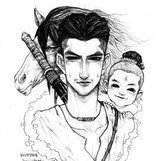
grabmywrist4
The Dao Bums-
Content count
54 -
Joined
-
Last visited
About grabmywrist4
-
Rank
Dao Bum
Recent Profile Visitors
-

Energy stuck in the head, insanity, anger, going nuts
grabmywrist4 replied to grabmywrist4's topic in General Discussion
A Tibetan Buddhist Guru. My practices now, everyday, are focusing on the breath, visualizing a white sphere four finger widths below my navel, chanting the Green Tara mantra, and focusing on my feet in walking meditation. Thanks for the advice about the tea -

Energy stuck in the head, insanity, anger, going nuts
grabmywrist4 replied to grabmywrist4's topic in General Discussion
Yes. I have moved the energy to my chest before. But then it just got stuck in my heart, and moved back up. I was also focusing on the earth element once, became really focused, and it temporarily dropped completely out of my head, which felt really good, but it just came back up again. -

Energy stuck in the head, insanity, anger, going nuts
grabmywrist4 posted a topic in General Discussion
I have had this problem for so many years. I have been to monks, I have been to teachers, I have seen my guru many times, nothing ever, ever, permanently fixes this problem. When I meditate, energy moves into my head, it builds into a giant ball of pressure, and then anger, delusion, confusion, and insanity start to arise as a result. For years I have tried to fix it, I have been taught so many techniques to fix it, nothing fixes this problem. When the pressure builds up in my head, it starts to hurt my heart and lungs below. I have felt like I was going to have a heart attack before. Every morning I wake up, there it is, the big ball of pressure stuck in my head, i meditate, it gets worse and worse. Everyday is another day of suffering and misery. Horrible horrible emotions constantly arising day after day due to this energy being stuck in my head. Is there anyone in this world that knows how to fix this problem? I haven't met one yet :\ -

Vipassana and unblocking energy channels
grabmywrist4 replied to grabmywrist4's topic in General Discussion
Hey. In the thai forest tradition "the one who knows" is spoken of. It is the unchanging, indestructible, knower, which creates the five aggregates of body and mind, and returns home after enlightenment. -

Vipassana and unblocking energy channels
grabmywrist4 replied to grabmywrist4's topic in General Discussion
And which one of the five hundred different interpretations of Buddhaghosa's Visshudmagga is the true and correct "classical Theravada" interpretation. Once we find the true and correct interpretation, then we can start interviewing all the monks that think Buddhaghosas interpretation of the tripitika wasn't even correct, and listen to the one thousand and one different interprations of the pali canon the Buddhaghosa deniers have. The Dhammakaya teaches Nirvana is the true self. Other teachers teach there is no self. Back in the day Thanissaro Bhikku speaks of people that would mention nirvana as an entity to invoke. Some people teach everything is the five aggregates, some say there's an unborn unchanging essence that creates the five aggregates and can exist independently of them. Some say the buddha taught breath meditation only at the nose tip, some people teach it at the stomach. Some say the Buddha is dead and you will never see him again, but some say the Buddha and arahants came to visit Ajahn Mun after his enlightenment. Which one is the true "classical Theravada?" Just look at the way the esoteric Theravada tradition differs in their interpretation of the Canon from the mainstreamers. “In mainstream Theravada the term ‘dhammakaya’ is interpreted in an entirely non metaphysical way. It is the corpus of the Buddha’s teaching contained, preeminently, in the canonical writings of the Tripitaka. For the esoteric tradition, however the concept has a special meaning. It is a transformed human body animated by the dhamma and understood as a series of sacred syllables. This transformed body possesses super mundane qualities, the most important being the thirty-two marks of a great man. To create this special body, the adept must use sound to awaken the crystal globe, or ‘infant in the womb,’ which is visualized in the region of the navel. Breathing exercises are also necessary.” Here you can find an article from a Nyingma practioner, David chapman, speaking of how the Buddhism we have today actually started in the 1860s as an anti colonial weapon used to fight back against western military and religion. https://meaningness.wordpress.com/2011/06/21/modern-buddhism-forged-as-anti-colonial-weapon/ Here he talks about the reinvention of Vipassana meditation, which prior to the 1800s, appears to have been lost. He mentions Asian Theravadins repeatedly reinvented meditation under the influence of western idea's. https://meaningness.wordpress.com/2011/07/07/theravada-reinvents-meditation/ To top it off, he speaks of the influence of protestant christianity on Buddhism as well as scientific skeptical rationalism. So when people speak of "classical Theravada" what they might actually be referring to, unknowingly, is a type of Buddhism created for political reasons, merged with protestant christianity and skeptical rationalism, topped with liberal leftist ethics, and served to the masses. If someone went to Laos or Cambodia they may find an entirely different Theravada than what they think of as classical. Here's a part of a technique in cambodia that you might not find on the front page of google from searching "theravada meditation" Bizot says the purpose of the meditation is to see the Buddha within the body, through tantric visualizations: “Repeating non-stop A RA HAM formula, the Venerable recognizes the purple letter NA at the entrance of his nose. He follows the nostril, goes through a door, takes a ladder down to the epiglottis where he reaches the blue letter MO. Climbing down a few more rungs to the neck, he gets to the yellow letter BU. He ten follows the sign of the red letters DDHA in his sternum. He finally reaches his navel, the seat of the letter YA whose color is that of crystal. He concentrates on his navel for the apparition of the Buddha sitting on the throne of Enlightenment. He inhales air and makes it go up and down from his nose to his navel. This exercise must lead him to distinguish a remote island that must be reached by crossing the ocean.” -

Vipassana and unblocking energy channels
grabmywrist4 replied to grabmywrist4's topic in General Discussion
Here is Shinzen a Vipassana teacher linking up meditation with Qi energy (and the holy spirit). He explains that insight into the impermanent nature of bodily sensations in Buddhism is actually a different way of describing deqi or "getting qi" "When a body worker massages you, their fingers move through your muscles and transfer energy into them. This works out the kinks and lumps in the substance of the muscles. This is a good analogy for Flow. When you let Flow work on you, the energy in its waves and vibrations breaks up the lumps in the substance of your soul. It works out the kinks in all six of your senses. This is flow as a purifier, something that breaks up blockages, cleans out impurities, refines the ore of your essence. As this is happening, it may seem as though the very substance of consciousness itself is becoming soft and porous. You can actually feel the waves and vibrations of anicca churning up gunk from the depths of your soul. It seems to cull up this inner ooze, break it up, and then excrete it out. You can literally feel the substance of your soul being scoured at a very deep level by the flow of impermanence. This cathartic aspect of impermanence is related to important ideas from other spiritual traditions. The words used in those traditions may not seem to refer to anything like impermanence conceptually. If you just looked at the literal meaning of these words, you would never in your wildest dreams imagine that they had anything to do with what Buddhists call impermanence. Take, for example, what in the Chinese medicine is referred to as qi (ch’i, or ki), which is described a kind of energy that flows through us in certain regular channels. When you receive an acupuncture treatment, and really tune into what is happening with the needles, you will have an experience called deqi,or“getting qi.”You feel expanding,contracting,vibrating waves going out from that needle, doing stuff that seems to be good for your body. You would never think that would be related to the Buddhist notion of Impermanence,but it is.As you’ll remember in Buddhist practice we get insight into impermanence by being very precise and very open to things. When the acupuncturist puts a needle in your skin, it produces a sensation of pain, a pin prick. It is not a big sensation, nothing more than a mosquito bite, so it is fairly easy to be completely open to that sensation, especially if you believe that the needle is going to help you. So when you are needled in acupuncture, it is easy to have equanimity with these little pin pricks. It is also easy to be very precise about them, very mindful about exactly where they are located. We even have a verb, to pinpoint. To pinpoint something means to be precise about it. So receiving acupuncture gives you an automatic experience of precise and equanamous body awareness. Compare this to what we do in mindfulness practice. When we meditate on the body, we attempt to be very precise about the locations of sensations and we try to have equanimity with them, to the best of our ability. In essence what we are doing is taking the ordinary aches and pains we experience while sitting, and converting them into a kind of acupuncture stimulus. Then they start to vibrate and spread in waves through us, and we experience deqi, we get the qi flow, which in Buddhism is described as “Insight into the impermanent nature of body sensations.” Impermanence is also related to what is called the Holy Spirit in the Western tradition. The phrase Holy Spirit may sound sort of mystical-schmystical, maybe even scary and off-putting. But the English words“holy spirit”come from the Latin spiritus sanctus, and the Latin phrase is just a translation of the Greek hagia pneuma, which in turn is a translation of the Hebrew ruach ha-kodesh.In Hebrew ruach means“the wind,”i.e.something that has power,but is insubstantial and constantly moving. The Holy Spirit is a kind of wind that blows through us and comforts us. It is the Paraclete, the comforter, which purifies us, and links us to our Source. It is the vehicle through which God’s grace is directly conveyed to us.So activating impermanence,receiving the Holy Spirit and getting qi, are very different words from very different traditions, but they are not entirely unrelated." -

Vipassana and unblocking energy channels
grabmywrist4 replied to grabmywrist4's topic in General Discussion
By "Classic theravada" do you mean reinvented Western Buddhism started by King Mongtuk due to British influence? https://meaningness.wordpress.com/2011/07/05/the-king-of-siam-invents-western-buddhism/ -

Vipassana and unblocking energy channels
grabmywrist4 replied to grabmywrist4's topic in General Discussion
Thanks. So we have Thanissaro Bhikku. Anyone else? -

Vipassana and unblocking energy channels
grabmywrist4 replied to grabmywrist4's topic in General Discussion
Thanks for the replies everyone. I'm looking for a vipassana teacher that explains vipassana in terms of it working with the energies. For example, Shinzen Young mentions in one of his teachings that when you use the technique the energy in the emotion will come unstuck a bit. This makes sense to me. I have the idea that on a deeper level the "watch things" vipassana technique is somehow unblocking the channels. i understand the "orthodox view" of vipassana is that it is just for discovering anicca, dukkha, and anatta. However, in places like thailand, there is for example, Ajahn Lee Dhammadaro, who taught about the breath energy channels, and there is Bhikku Thanissaro who talks about unblocking the energy channels. When I was staying at a monastery I was able to talk to the Abott there about the breath energy and manipulation of energy in the body and he knew what I was talking about. It might surprise some people to know that Theravada Buddhism in places like thailand is extremely diverse, with Theravada Buddhists practicing visualization of certain letters combined with colors moving through the middle channel (Tantric Theravada), or people that believe the middle way is actually the middle channel. I remember a guy I knew who was ordained in Thailand for around 5 years that told me about a practice one of his teachers was having him do that sounded like pushing energy through the channels. I had one Theravada Bhikkhu telling me to intentionally move energy out of my head into my heart. Here is Bhikkhu Thanissaro talking some about the breath energy and channels. And for anyone interested, you can find some stuff from Ajahn Lee Dhammadaro on the internet talking about the different energy centers in the body where certain magical powers manifest, such as the tip of the nose. In Theravada many teachers teach to focus on the tip of the nose. But does anyone actually know why? As Ajahn Lee Dhammadaro says, the tip of the nose is one of the energy centers where magical powers are developed. This is what I consider a "deeper teaching". There is the simple teaching that many people will give, for example put your mind on the tip of the nose just for concentration, or whatever. But then there is the deeper teaching, that there is a special energy center there. What I'm looking for is a teacher that goes deeper into Vipassana and teaches it on a deeper level. And the type of vipassana technique I'm looking for is the "watch things" technique. Everyone from Goenka, to Mahasi Sayadaw, to Thich Nhat Hanh, to sayadaw U pandita, I consider to be teaching a style of this "watch things" technique. -
Anyone know of any Vipassana teachers that explain what the method does to the energy in the body? thanks.
-

Sharing kung fu real combat videos.
grabmywrist4 replied to grabmywrist4's topic in General Discussion
Do you have any clips of the Okinawa dance? And it seems that clip is a scene from a movie shot at a different angle. the movie is called never back down. Here is the movie version clip. And anyone else here feel free to share any kung fu/ traditional martial art combat videos you know of =D -

Sharing kung fu real combat videos.
grabmywrist4 replied to grabmywrist4's topic in General Discussion
lol Capoeira. https://www.youtube.com/watch?v=hNYklGAr0Vg -

Sharing kung fu real combat videos.
grabmywrist4 replied to grabmywrist4's topic in General Discussion
The guy looked to be confident at the beginning with some punches and a kick but then the slap guy just comes in with palms of fury and completely overwhelms him. Do you have any other video's to add to the thread Marblehead? =D -

Sharing kung fu real combat videos.
grabmywrist4 replied to grabmywrist4's topic in General Discussion
Grand master pimp slap. Is he using iron palm? Wing chun guy sends someone into a window -
First three are Taijiquan. The third one might be Taijiquan too, not sure. anyone else have other findings?



